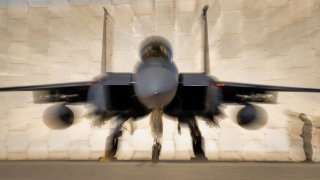F-15N Sea Eagle: How the F-15 Fighter Almost Flew From Aircraft Carriers
In the 1970s, the U.S. Navy briefly considered replacing the iconic F-14 Tomcat with a modified F-15N Sea Eagle for aircraft carrier operations. The F-15N aimed to be faster, lighter, more maneuverable, and cheaper than the Tomcat, which faced high maintenance costs and mechanical issues, particularly with its TF-30 engines.
In order to make the F-15 suitable for aircraft carriers, McDonnel Douglas knew the platform would have to be modified. The F-15A already had a tailhook, intended for use on short airstrips or in an emergency, but a carrier fighter needs to rely on its hook for every landing, so a larger reinforced hook was added to the design. To make for easier storage below deck on carriers, the wings would fold up at a 90-degree angle a bit more than 15 feet from each tip. The landing gear would also have to be swapped out for a more rugged set that could withstand the abuse of carrier landings on a rocking ship. McDonnell Douglas said they’d set about designing the new gear if the Navy wanted to move forward with the aircraft.
With these changes incorporated, the F-15 only gained a paltry 3,000 pounds, which, combined with better maneuverability, a higher top speed, and a much lower price, all made this new Sea Eagle sound like a pretty good deal… but there was one glaring shortcoming. Capable as the F-15N may have been, it couldn’t carry America’s latest and greatest air-to-air missile, the AIM-54 Pheonix.
The Phoenix missile had been developed for the Navy’s defunct F-111B fleet carrier fighter effort that McDonnel Douglas had also been involved with, so the firm logically migrated it and its supporting systems to their new Tomcat. The AN/AWG-9 radar developed specifically for use with the AIM-54 Phoenix was capable of tracking up to six separate targets at ranges as far as 100 miles. When coupled with a bevy of 13-foot-long Phoenix missiles, it made the F-14 an air-to-air opponent without equal.
In fact, the combination of the Phoenix missile and AN/AWG-9 was so potent, some believed it offset the F-14’s engine woes, arguing that the fighter didn’t need to be fast and maneuverable when it could shoot its enemies down from such long ranges.
Putting the F-15 on America’s aircraft carriers might have been cheaper, and the aircraft itself may even have been better in some respects, but without Phoenix missiles, the Navy just wasn’t interested. However, McDonnell Douglas remained undeterred, enlisting the help of Hughes Aircraft (designers of the AIM-54) and returning to the drawing board to devise a version of their aircraft carrier F-15 that could wield the Pheonix as effectively as the massive but mighty Tomcat.
But it wasn’t as simple as slapping these missiles onto the F-15’s existing hardpoints. Not only were the weapons relatively large, but so was the AN/AWG-9 radar needed to run them. The hefty Tomcat could carry a maximum of six Phoenix missiles, but famously couldn’t land with all six still onboard. If ever an F-14 scrambled to intercept Soviet bombers with 6 missiles and returned without firing them, the pilot would have to dump a few into the ocean in order to land safely. Fitting these weapons onto the F-15 was enough work to warrant a new title, and the updated Sea Eagle was dubbed the F-15N-PHX. But with all that added firepower, the new F-15N-PHX weighed in at 10,000 pounds heavier than a standard F-15, totally eliminating its performance advantage over the Tomcat.
In 1973, a Senate subcommittee convened to decide what fighter the Navy would fly into the future, with the F-14, new F-15N, a stripped-down iteration of the F-14, and a heavily upgraded version of the F-4 all considered to varying extents. Senator Thomas Eagleton, who was a Navy veteran himself, proposed a fly-off between the F-15N and the F-14, but it never manifested.
In the end, the U.S. Navy chose to stick with the Tomcat, and surprisingly enough, even the U.S. Air Force found itself looking for a cheaper alternative to the F-15 just a few short years later. Like the Tomcat, the F-15 was incredibly capable, but also rather pricey. The effort to field a lower-cost fighter to complement the F-15 eventually produced the F-16 Fighting Falcon, which the Pentagon would also press for duty aboard aircraft carriers, before the F/A-18 Hornet came about.
The F-15 is far from the only unusual aircraft to be pitched for carrier duty. Make sure to check out our articles about efforts to put the F-16, the F-22, and the F-117 on aircraft carriers, or you can read about how the U.S. really did fly C-130s and even U-2 spy planes off of them during the Cold War.
Want to learn more about the F-15? Check out the Frankenstein F-15 that was better than the one we got here, or how a pilot landed an F-15 after it lost an entire wing here.
About the Author
Alex Hollings is a writer, dad, and Marine veteran.
This article was first published by Sandboxx News.


